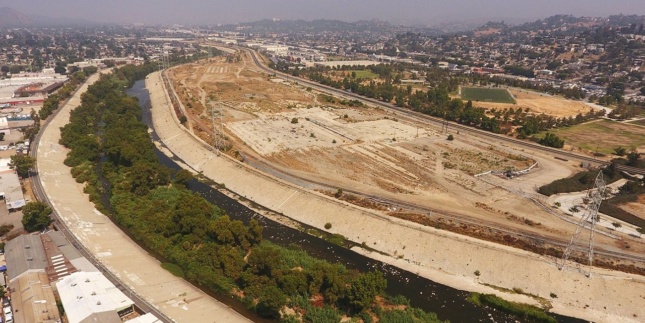The L.A. River is not to Los Angeles as the Seine is to Paris, nor the Thames to London. Its 51 miles of concrete were not designed to become a uniting landmark when they were first poured in 1938, but rather as a functional safeguard against an infamous flood that devastated the city in March of that year. Though it currently provides a handful of narrow parks, bike trails and opportunities for brief kayaking excursions along its winding path between its mouth in Long Beach and the flats of Canoga Park, the LA River has widely been dismissed as little more than a blight in the neighborhoods it divides in half. Only within the last few years, however, has the city funded drastic improvements to the appearance and functionality of the Mighty L.A.
Revisiting the loosely organized LA River Master Plan of 1996, the city has most recently focused its attention on Taylor Yard (also known as the G2 parcel), a 42-acre parcel sitting on the river’s midway marker near Mount Washington that was once a hub for the Southern Pacific Railroad freight trains that enabled the city’s growth in the first half of the 20th century. After purchasing the land for $60 million, the city invited firms WSP and Studio MLA (Mia Lehrer + Associates) to collaborate on three separate visions (viewable here and released in June) for the abandoned site’s future as a public park, each of which is distinguished by varying levels of interaction with the river: “Island” would blend the park and the river with the addition of an artificial island (in a formal gesture reminiscent of the Ile de la Cité in Paris); “Soft Edge” would provide a large, flat park set against the river without obstructing its path; and “The Yards” would feature a radial plan with a raised circular platform at its center from which visitors can observe the river and the city from a vantage point.

The unifying consideration for each of the three plans, however, is to replace the prohibitive fencing along the L.A. River with amenities which will draw visitors close to its edge. “With Taylor Yard,” Mia Lehrer expressed, “our hope is to create experiences at different scales that are very close to nature and also celebratory of the community.” Whichever plan is selected will have to incorporate a viewing platform to be completed next year by SelgasCano, the Spanish firm behind Second Home and the Serpentine Pavilion currently parked at the La Brea Tar Pits.
The Taylor Yards project will be opened to the public in shifts, the last of which is expected to be completed at least ten years from now. “The objective of a phased approach is to address required remediation as funding is available,” said Michael Drennan, project manager for WSP, “while allowing more immediate public use of portions of the site, along with interim site uses for natural flora and fauna.”











